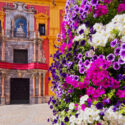If you are planning to spend your Easter holidays in Malaga, from the 1st to the 8th of April you will be able to experience what the Spanish call “La Semana Santa” (The Holy Week), a beautiful, religious tradition that fills the streets with several processions witnessed by literally thousands of devoted followers.
The people of Malaga live this Holy Week with special jubilation and sing “Saetas” (typical Andalusian devotional songs of the Holy Week) to the Virgin, the penitent and the Crucified Christ that are carried upon thrones on the shoulders of the locals themselves during these processions. This Christian tradition has a great cultural richness accumulated over many centuries.
There are eighteen religious brotherhoods in total. Each one of these belong to an association that prepare for this holy week during the whole year so they can parade their very own sacred throne, on a specific day. Some have only one, others have up to two or three. The most well-known brotherhoods in Malaga are: ‘Los Gitanos’ (The Gypsies), ‘Los Estudiantes’ (The Students) or ‘El Cautivo’ (The Captive) for example, but they all have one thing in common, they all carry very heavy, carefully detailed and dressed-up platforms that hold real masterpieces of great polychrome that were carved in wood many centuries ago.
“I’m not a believer, but this is my Christ”, claims Mario while he carries upon his shoulder one of the metal bars that holds the throne that weighs over five thousand kilos (11.000 pounds). Around 50 or 60 people carry this throne, some are placed on the outside, on each side and others are placed underneath the platform where it is so dark they can barely see. An effort that leads to severe pain and swelling of the shoulder after eight hours of walking, supporting that kind of weight.
The culminating moment of every procession is when each throne ends its route through the streets and is carried into its respective church. At this point, art and religion seems to merge into one. It’s probably the most emotive moment of the event, where everyone applauds and cheers on; and even a few tears shed by the more devoted followers.
Whether you are religious or not, it’s almost impossible not to be moved. The atmosphere is so animated and emotional. Without a doubt, the Holy Week in Andalusia is a tradition that is an integral part of the culture and really does reflect the spirit of the people.
Malaga city
The capital city of Malaga province is surrounded by mountains to the North and by the Mediterranean Sea to the South. A city represented by the Alcazaba, the Gibralfaro Castle and its great Cathedral, amongst others. This last one is a monumental building with a Baroque facade and a Renaissance interior that was built on top of the remains of an old mosque many centuries ago. On the hand, the urban centre of Malaga where you’ll find and endless labyrinth of streets packed with shops, bars and restaurants is called Larios.
Other places of interest for example are the Roman Theatre and the Picasso Museum, but the coast, down on the sea front, is probably the visitor’s favourite spot when visiting Malaga and the Costa del Sol as it’s the perfect location to enjoy the sun on the beach or to sit down in one of the many beach bars (or as the locals call them, ‘chiringuitos’) and try the typical fried fish or the traditional dish of Sardines on the spit (Espetos), always accompanied by a chilled Andalusian beer.
Hope you enjoy your stay in Malaga, you’ll definitely want to return!







Comments